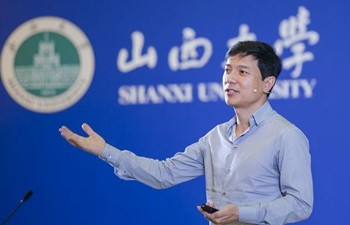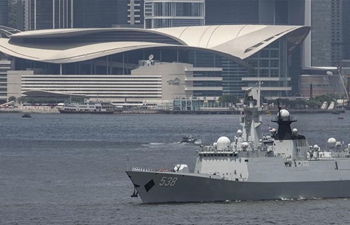TAIYUAN, July 12 (Xinhua) -- Shanxi merchants are famous in Chinese history for the dominant role they played in finance and trade during the Ming and Qing dynasties.
Today, Shanxi businessmen are trying to turn Qixian county, the birthplace of the province's merchant culture, into a world-famous glass-making town.
After melting over 30 kinds of raw materials in a furnace, Hou Binghu, a glass-blower, uses an iron pipe to blow molten glass into a mold.
This magical scene of hand-blown glass, an ancient method to make glass jars, vases and glass ornaments, was seen in a glass art park owned by Hong Hai Glass Company of Qixian county.
Using freehand sketching and gilding, the semi-finished products can be turned into exquisite essential oil bottles, coffee cups and snuff bottles.
Hou is among 20,000 local residents employed in the glass industry, the pillar industry of Qianxian's economy.
Qixian boasts 42 glass manufacturing factories and produces glass products weighing a total of 20 tonnes each year, ranging from wine glasses and tea sets to vases and jars.
Hong Hai Glass Company was one of the first glass makers in the county. Since it opened in 1953, the factory has stuck to traditional hand-blown glass and acquired 28 glass-making patents.
While machine-blown glass is more cost effective and suitable for mass production, Li Jiansheng, general manager of Hong Hai, and other businessmen in Qixian still prefer hand-blown glass.
"Such technique is more precise and appropriate for unique and customized glass pieces," Li said.
He said that 70 percent of their products were exported. Every year, they export hand blown glassware with a value of more than 30 million yuan (4.4 million U.S. dollars) to the Middle East.
Now, the traditional craft of hand-blown glass has been promoted in an industry tourism program in Qixian.
In Hong Hai glass-art park, tourists can watch glass blowing and the process of turning raw materials into colored-glass art work. They can also buy glassware.
The park attracts more than 100,000 tourists every year.
The local government claims that the county produces more than 50 percent of hand-blown glass products in China, and its products are exported to more than 80 countries and regions.
Qixian is just one of the places across China working to boost innovation and specialized industries to transform the economy.
Liuzhou, a traditional industrial city best known for its steel and automobile manufacturing in Guangxi Zhuang Autonomous Region, has been promoting its signature street food "Luosifen," a river-snail rice noodle dish, to more dining tables at home and abroad. Sales of Luosifen generated 1.5 billion yuan last year.
Pingyang county in eastern China's Zhejiang Province, once known as China's town of leather, has transformed its economy into a pet products producer and pet tourist destination. It is home to 72 pet product manufacturers. Last year, the output of its pet industry reached 3 billion yuan.
A glass museum is currently being constructed in Qixian.
"I'm happy if we can turn the county into a global exhibition center of hand-blown glass art work. But I'm happier to see that we can keep this ancient art alive," Li said.

















